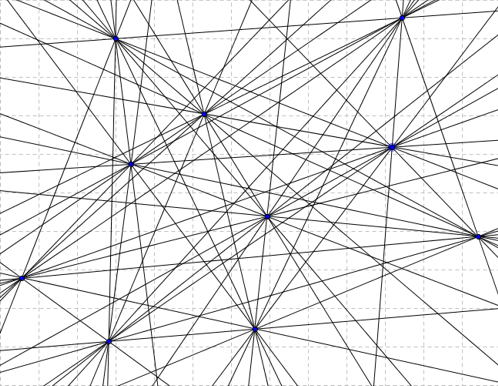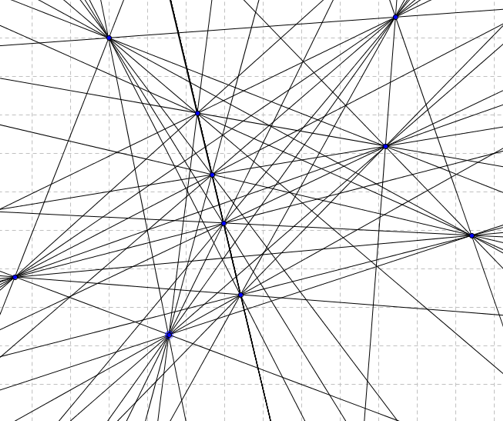This lesson will cover a few more examples relating to combinations. Let’s begin.
Example 1 There are 10 points in a plane, no 3 of which are collinear. How many different lines can be formed by joining these points?
Solution To form a line, all we need to do is select any 2 points (subtask 1), and then join them (subtask 2). The number of ways to select any points (out of 10 distinct points) will be 10C2. Once we select the points, there is only 1 straight line which will be formed using these points. Therefore the number of lines will be 10C2 x 1 or 45. Here’s a crazy figure to illustrate.

Example 2 Suppose 4 of the 10 points in the previous example were collinear, and no three of the remaining are collinear. Find the number of straight lines which can be formed. Also find the number of triangles which can be formed.
Solution Since 4 particular points are now collinear, there will be only 1 line which will be formed by joining any 2 of these 4, instead of 4C2 if they had been non collinear. So, we’ve lost 4C2 or 6 lines, and instead we got only 1. Therefore, the total number of lines will be 10C2 – 4C2 + 1 = 40
There is one more way in which we can calculate the number of lines. Let’s divide the points in two groups: the collinear group of 4 points, and the non-collinear group of 6 points.
To count the number of lines, we have three possible cases. First, the lines formed using the points of the collinear group – only 1 line. Second, the lines formed using only the points of the non-collinear group – 6C2 or 15 lines. Third, select one point from the collinear group (4C1 ways) and the other from the non-collinear group (6C1 ways) – the number of such lines will be 4C1 x 6C1 = 24.
Therefore the total number of lines will be 1 + 15 + 24 = 40. This was a bit longer method, but nevertheless an important method of counting – dividing into subcases and adding the results together. Another crazy figure..

What about the number of triangles?
Suppose all of the points were non-collinear. The number of triangles would have been 10C3, because to form a triangle, we need to select any three points.
But! There are four culprit points, which won’t form a triangle, as they are collinear. We’ve lost 4C3 triangles, which would have been formed, had these 4 been non-collinear.
Therefore, the total number of triangles is 10C3 – 4C3.
Try using the second method (of making cases) and see if you arrive at the same answer.
Example 3 A deck of cards contains 52 cards with 4 different suits, and 13 kinds of cards in each suit, as shown below.
A♠ 2♠ 3♠ 4♠ 5♠ 6♠ 7♠ 8♠ 9♠ 10♠ J♠ Q♠ K♠
A♥ 2♥ 3♥ 4♥ 5♥ 6♥ 7♥ 8♥ 9♥ 10♥ J♥ Q♥ K♥
A♦ 2♦ 3♦ 4♦ 5♦ 6♦ 7♦ 8♦ 9♦ 10♦ J♦ Q♦ K♦
A♣ 2♣ 3♣ 4♣ 5♣ 6♣ 7♣ 8♣ 9♣ 10♣ J♣ Q♣ K♣
Consider a card game, in which each player is dealt 5 cards. In how many ways can a player obtain the following combinations?
(i) All cards of the same suit:
3♥ 7♥ 8♥ 9♥ K♥
(ii) Two cards of the same kind and the rest three of the same kind:
4♥ 4♠ K♥ K♣ K♦
(iii) Two cards of the same kind and rest all different:
4♥ 4♠ K♥ 9♣ 7♦
(iv) Cards in sequence:
4♥ 5♠ 6♥ 7♣ 8♦
Solution Note that the order of the cards in a player’s hand is irrelevant. We are only interested in the combination of cards.
(i) If we need 5 cards of the same suit, we’ll first have to select a suit, in 4C1 ways. We now have a suit of 13 different cards, of which 5 cards need to be selected. This can be done in 13C5 ways. Therefore the total number of ways will be 4C1 x 13C5 = 5148
(ii) We’ll divide this task into the following subtasks – select the kind to be paired, then select 2 cards of that kind. Then select the kind to be tripled, then select 3 cards of that kind.
For the pair we first select the kind in 13C1 ways, and then select any two cards of that kind in 4C2 ways.
We are now left with 48 cards, 12 kinds of cards of 4 different suits. Now we’ll select another kind in 12C1 ways and select 3 cards of that kind in 4C3 ways.
The total number of combinations is therefore 13C1 x 4C2 x 12C1 x 4C3 = 3744
(iii) Similar to the previous part we can select the pair in 13C1 x 4C2 ways. But now we have to be careful. Of the 48 cards remaining, we cannot select any 3 cards, because it might happen they all are of the same kind.
To handle this, we’ll first select 3 different kinds, in 12C3 ways, say we get 5, 8 and K. Now each of these cards can be of any of the 4 suits. There are 4 possibilities for the ‘5’, 4 for the ‘8’ and 4 for the ‘K’. That means, for a given selection of 3 kinds of cards, there are 4 x 4 x 4 or 64 different combinations.
Therefore, the total number of combinations of the remaining 3 cards will be 12C3 x 64, making the answer equal to 13C1 x 4C2 x 12C3 x 64 = 1098240
(iv) In this case we’ll first select the sequence to be formed. There are 9 possibilities: (A,2,3,4,5), (2,3,4,5,6) … (9, 10, J, Q, K). Similar to the previous part, there will be 4 possibilities for each of the 5 cards selected. Therefore the total number of combinations will be 9 x 4 x 4 x 4 x 4 x 4 = 147456
Perplexed? Me too! Try a few more cases yourself..
(v) Two pairs, and the fifth card different
4♠ 4♥ 5♣ 5♦ K♦
(vi) Three of the same kind, and the rest two different
7♠ 7♥ 7♣ 4♦ K♣
(vii) Four of the same kind
4♠ 4♥ 4♣ 4♦ K♦
.. and I’ll meet you in the next lesson.